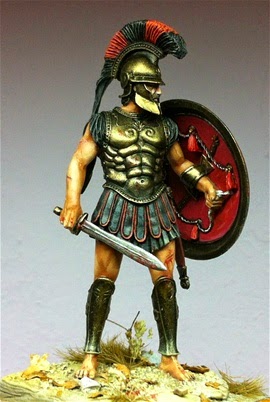ANCIENTS by Ivan Withers.
1. What's "Ancients" ?
"Ancients"
is the name given by wargamers (and others) to the entire period of history
before the invention of gunpowder.[1]
If one considers recorded history to have started about 3,000 BC, it spans some
four thousand years. Wargamers who call themselves "Ancients"
therefore have a very wide choice of periods, peoples and cultures.
The
earliest known organised warriors are those of the Sumerians, originating in
the so-called Fertile Crescent of the Middle East .
As time rolled by, such peoples as the Egyptians, the Assyrians, the Greeks,
the Trojans, the Han, the Romans, the Mayans, the Saxons, the Vikings and many
others appeared. The list of possible
armies and weapons to discover is huge.
2. Where Do I Start ?
Choosing
a period to start may therefore seem a bit daunting. However, somewhere you may have seen some
friends playing a game, or perhaps you already have an idea about which
particular army interests you enough to start. If you are still a bit doubtful,
how about the Romans? Mind you, even having narrowed your choice down to this
one particular people, there is still a pretty wide choice. The Romans started
out as an obscure Latin village ruled by a foreign king and they provided
troops for an imitation-early-Greek-type phalanx. After they kicked out their
Etruscan overlords, they evolved into a Republic, which lasted for some
hundreds of years before they put a king (sorry, Caesar) back in charge. During this span of time they had at least
three quite different organisations and armies. Not quite at random, let's
settle on the Romans at the time of
Tiberius; that's say roughly 10 AD to about 35 AD. This period of Roman history
is the best documented. The information
for the Roman Army a this time can therefore be found quite easily.
3.
Starting With Romans.
 |
| Airfix Romans |
4.Playing
With the "Toy Soldiers".
Playing
with "Ancients" need not just involve the figure you buy straight out
of the packet, either. When you feel confident you can try conversions; i.e.,
making changes to the figures to look quite different. Again there are many
books and magazines which can help you.
Some of your fellow club-mates even make their own moulds to cast their
own figures.
5.By
What Rules Shall I Play?
However
you play, whatever you play, there must always be Rules. Rules for fighting
Ancient Wargames come in many different varieties, simple or complex, cheap or
expensive. Again your choice will be
governed by local conditions. What rules
do your prospective opponents use? What is available locally in shops?
The WRG (short for
Wargames Research Group) in England
THE
GREEK HOPLITE
 |
| Greek Hoplite |
Greek
cities in the ancient world were very often at war with some other city or
cities, due to a bewildering number of causes. One particular "polis"
might be at war because of traditional alliances and enemies, and that war
could be as short as a week, or as long as a generation. In the longer wars,
the friends and enemies could change many times.
The
typical Greek warrior was most often a small farmer. There was no standing army. His city would in effect call out a levy, and
our warrior would leave his livelihood for weeks or even months, leaving his
family to fend for themselves. He provided his own war-gear, or panoply. Since
metal was relatively scarce and hence expensive, his panoply would be as expensive
to him as buying a car is to us - and with a similar wide choice of results and efficiency.
 |
| Greek Hoplite Phalanx |
The
hoplite's principal weapon was a spear, varying in length and type over the
centuries. At the time of the wars with Persia
 |
| Hoplite Helmets |
It
appears that, at least in the earlier periods, hoplites often went into battle
naked, or wearing only a loin cloth, perhaps. At least this would help them run
more fleetly than pursuers after they'd dropped their shields and spears! For
below-the-waist security, the well-dressed hoplite often wore a frontal
protection made up of leather strips. This idea was the forerunner of the Later
Roman Pteruges. Greaves were like light-weight bronze shin-pads. The existing
contemporary art isn't clear whether they were thin bronze shapes which sprung
over the shin, or heavier protection more like today's cricketers' pads.
With
all this aggressive individuality, how was it that the Greek fighting machine
was so successful? Against all probability, these aggressive individualists had
developed into the most effective team-players the world had seen up until that
time. Provided they set up their formation in time (which later turned out to
be a BIG proviso), then the only formation of anywhere near the same numbers
which could defeat them was a similar phalanx. As long as the phalanx kept its
formation, it could only be beaten by a similar formation unless greatly
outnumbered. Alexander simply gave his virtually unstoppable phalanx longer
spears which out-reached even the Greeks spears, at the price of even further
rigidity. But Alex realised the weakness and supported the flanks with more
flexible bodies of troops. Nevertheless, the Romans beat the phalanx because of
the inherent flexibility of the legion. They effectively trimmed away the
cohesion and exposed the vulnerable flanks.
This
same idea of the pike-armed phalanx came to light briefly centuries later, when
the Swiss army had its day in the limelight during the Renaissance. It failed
eventually because of its rigidity, and the new weapon of gunpowder.
The
GREEK PELTAST
 |
| GREEK PELTAST |
The
peltasts principal armament was two, possibly three javelins, varying in length
and type over the centuries. At the time of the wars with Persia
The
hoplites rather naturally looked down upon the poorly equipped peltasts as
inferiors both socially and in battle usefullness. It came as a horrible shock
during the wars between Sparta


No comments:
Post a Comment